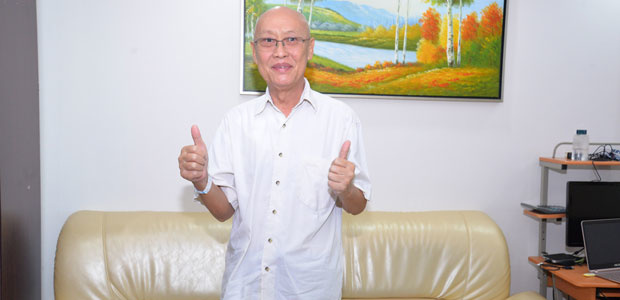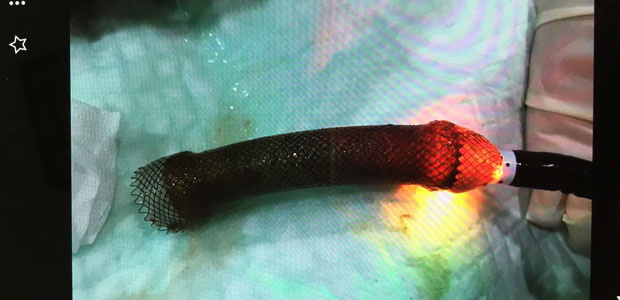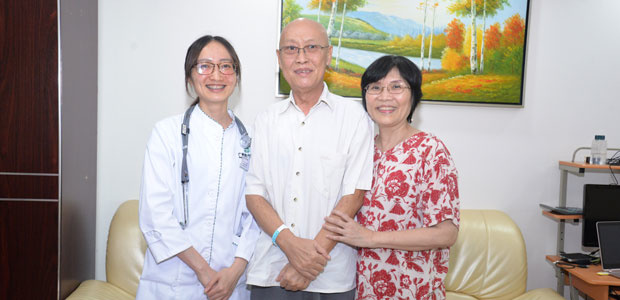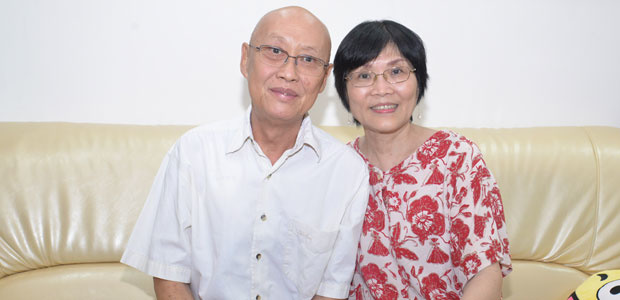Lam Wen Fung, 65 years old, is an esophageal cancer patient from Surabaya, Indonesia. He was diagnosed in October 2016 and came to St. Stamford Modern Cancer Hospital Guangzhou on February 14, 2017 after refusing operation and chemoradiotherapy suggested by Indonesian doctor. After photodynamic therapy and six sessions of interventional therapy combined with traditional Chinese medicine (TCM) & western medicine, his condition was effectively controlled. In June, during recuperation in Indonesia, Lam felt something unusual in his stomach, which caused slight discomfort. After CT check in local hospital, it turned out his esophageal stent had slipped into his stomach, indicating that his tumor was effectively treated and significantly shrank.

Lam Wen Fung
What is Photodynamic Therapy?
“The reason that Lam had an esophageal stent was his tumors had invaded his lower esophagus, causing difficulty in swallowing. The detachment of esophageal stent indicated his treatments in St. Stamford Modern Cancer Hospital Guangzhou have made great progress in which significantly shrank his tumors in lower esophagus. Now he just needs to take out the stent and he will no longer need the it to sustain the function of esophagus.”Lam’s attending doctor Dr. Liang Feilv explained.

Esophageal stent, 12.5cm long and 2cm in diameter
Since last October, Lam started to lose appetite and could not intake liquid and would vomit. Additionally, he could not lie flat on the bed to sleep and he lost his weight by 20 kilogram. He didn’t go to a local hospital until February 2017, and the pathology showed that there were tumors in his lower esophagus, which already invaded 30% of his stomach, causing obstruction in his lower esophagus and difficulty in his feeding. Because food cannot get to Lam’s stomach when it arrives at his cardia (of stomach), doctor in Jakarta implanted a stent to allow passage of food. Besides, local doctor suggested stomach excision and chemoradiotherapy treatments in Japan to Lam but he refused in view of serious side effects. Later on, his daughters got to know St. Stamford Modern Cancer Hospital Guangzhou and its minimally invasive treatment technologies through the Internet. Accompanied by his family, Lam went to Surabaya Office of St. Stamford Modern Cancer Hospital Guangzhou to learn more about the hospital and its technologies.

Lam Wen Fung and Dr. Liang Feilv
After six days, Lam and his wife decided to go to St. Stamford Modern Cancer Hospital Guangzhou in China for treatments. In February 14, 2017, the couple flew to China. They were warmly received by medical staff and interpreter in St. Stamford Modern Cancer Hospital Guangzhou and arranged in the ward picked by Dr. Liang Feilv. Lam then was very weak and he could only drink water, barely eats food even porridge could get stuck in his esophagus. He felt burning pain in his upper abdomen and had to take anodyne medicine. Also, had bouts of hiccups and gastric acidity sensation. After thorough tests and examinations, he was diagnosed as Stage III Esophageal Cancer.

Lam Wen Fung and his wife
Multidisciplinary Team (MDT) in St. Stamford Modern Cancer Hospital Guangzhou tailored a treatment plan with photodynamic therapy and interventional therapy for Lam after detailed discussion and diagnosis. In Feb. 19, Lam had his first interventional therapy. Then on early March, after he had photodynamic therapy, his tumor has remarkably shrunk and could eat normally. Dr. Liang told me that interventional therapy is performed under the guidance of CT imaging equipment. Then a special tube with chemo drugs is introduced to the cancer cells to precisely kill tumors without destroying the normal cells. Lam explained “I had difficulties in breathing for two times during the operation and beyond that I didn’t feel any side effect. I felt better and better. And photodynamic therapy was done after my third interventional therapy. It’s said that a photosensitizing agent is injected into my body; the agent is absorbed by cells all over the body but stays in cancer cells longer than it does in normal cells.” The tumor is exposed to light when most of the agent has disappeared from normal cells but remains in cancer cells. The photosensitizing agent in the tumor absorbs the light and produces an active form of oxygen that can destroy nearby cancer cells. Lam added, “I also had the minimally invasive targeted therapy and combination of traditional Chinese medicine (TCM) & western medicine to enhance my immunity, which indeed improved my sleep quality and helped treat my cancer.” Currently, Lam’s cancer has been effectively treated and well controlled, which only requires regular visit. He is grateful to his wife, who took good care of him during his stay. And he suggests all the patients here to cooperate with doctor’s treatment and have periodical body check-up.






 Telephone:
Telephone: